Wahoo Kickr V6 direct drive smart trainer review - is the update worth the extra spend?
The Wahoo Kickr has continuously ranked as one of the best direct drive smart trainers your money can buy. Can its latest developments keep it at the head of the pack?
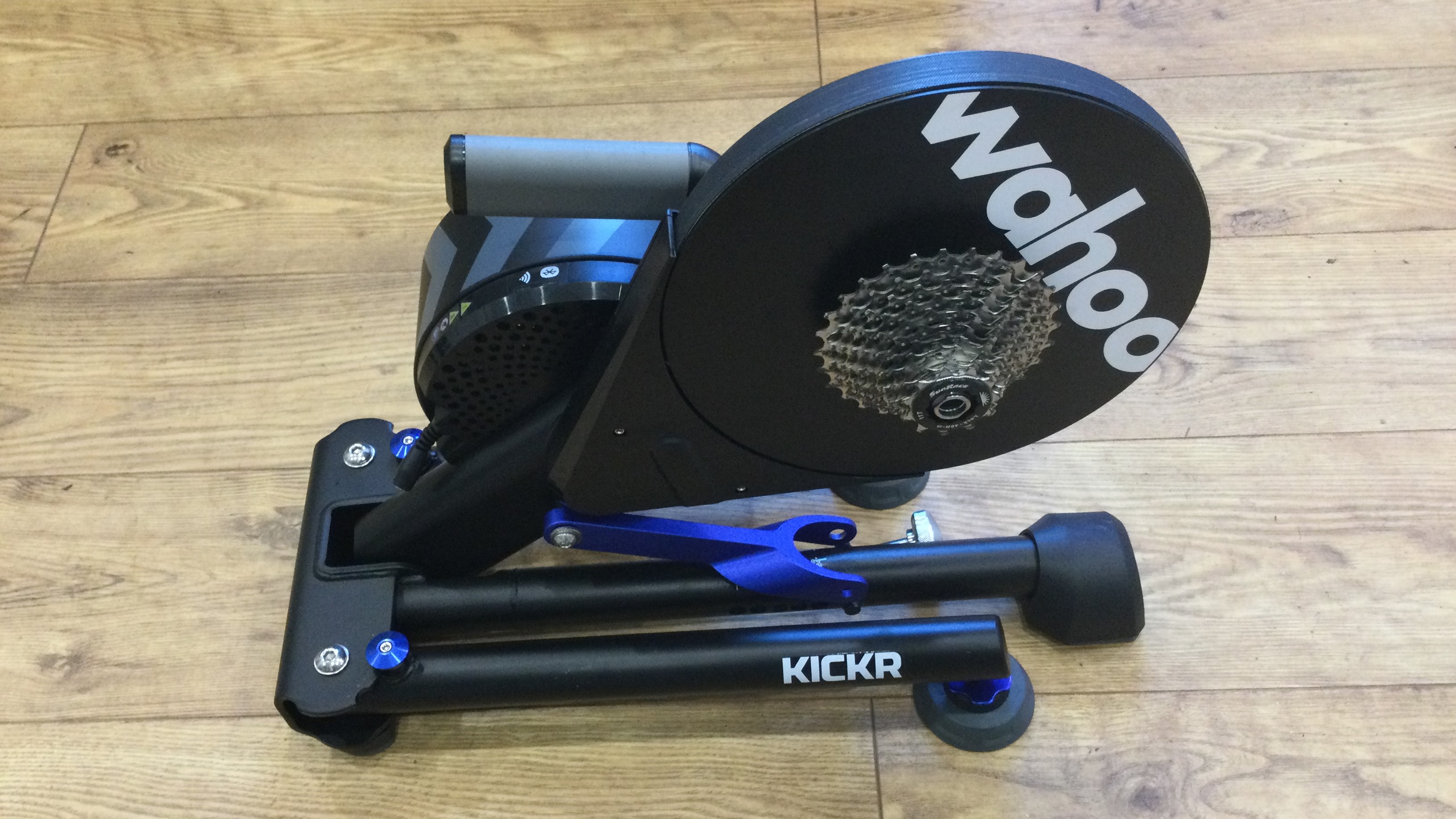
Wahoo has added a couple of features to the high end Kickr that yet again will improve the indoor training experience: WiFi offers a faster and more stable connection (if your router is up to it) and the ERG ramp setting prevents you becoming ground down in a power tussle if you dare slack off the pedals during an effort. This is all on top of the 2,200W max output, -10 to +20% simulated grade and +/- 1% power accuracy of the electromagnetic resisted smart trainer. But like the top models across different brands, this all comes at a price that you may not be willing to pay, especially given the price and performance of older or less high-end models.
-
+
Great feel and capability
-
+
WiFi improves speed and stability of connection
-
+
Easy set up
-
+
Automatic calibration and firmware updated
-
-
Connectivity is still not guaranteed, including with Wahoo's own apps
-
-
Expense
-
-
May need to buy an additional cassette / freewheel so compatible with your bike
You can trust Cycling Weekly.
Over the last few months there seems to have been an almost constant release of updated indoor smart bikes and trainers to see us through our winter. I set out to see how the latest version of the Wahoo Kickr direct drive smart trainer fares amongst our best turbo trainers and whether it keeps its reputation as one of the best high-end models on the market.
Wahoo Kickr V6: construction

The Wahoo Kickr V6 direct drive smart trainer’s spec is impressive:
· 16lb flywheel with electromagnetic resistance
· Adjustable AXIS feet for side to side motion
· ANT+, ANT+ FE-C, WiFi, Bluetooth, Direct connect
· Maximum Power Output: 2,200 Watts
· Maximum Simulated Grade: 20%
· Minimum Simulated Grade: -10%
· Claimed Power Accuracy: +/-1%
Most of this we’d already seen on the previous (V5, 2020) version of the Kickr. In comparison to the previous model, the new additions are the WiFi connectivity, ERG Easy ramp and a trainer odometer.
It was already possible to connect your Kickr to your home router either via a hardwire connection or using a dongle. Now the integrated WiFi makes it far easier to get a faster and more reliable connectivity to your paired devices via a 2.4 Ghz network. It also allows automatic firmware updates so you don’t need to remember to manually log into the app.
Alongside the WiFi, the ERG Easy ramp is probably the biggest change you’ll notice. This new feature allows 10 secs of ramped resistance to get back up to cadence if you’ve stopped mid interval. This is a big improvement from the previous approach which just upped the resistance to something unobtainable and thus grinded you to a halt.
It’s hard to see the value of the odometer on the Kickr. From a training point of view there’s much richer available data through which ever app / system you use to control and record your workouts. It’s been said that the odometer will be useful when it comes to re-sale / second hand buying – but that strikes me as much of a curse than a blessing; we all know that a well-used but well cared for machine can often be a better buy than a little-used neglected one.
Wahoo Kickr V6: Compatibility and setup
Out the box setting up the hardware is straightforward and there’s a short printed quick start guide to help you through. The legs fan out and there’s a big adjustment pin to hinge the trainer to different positions for different sized wheels which are clearly marked.
Naturally the Kickr is pretty hefty (>20kg) but there is a well-balanced carry handle. It does fold down, but not to a particularly compact size (37cm/14.5" high) so you’re unlikely to be able to push it under your bed or sofa when it’s not in use.
There are three sets of AXIS feet to give a ‘realistic ride feel’ by allowing some side to side movement. The installed set were (nearly) the right ones for my weight so I didn’t bother swapping them over.
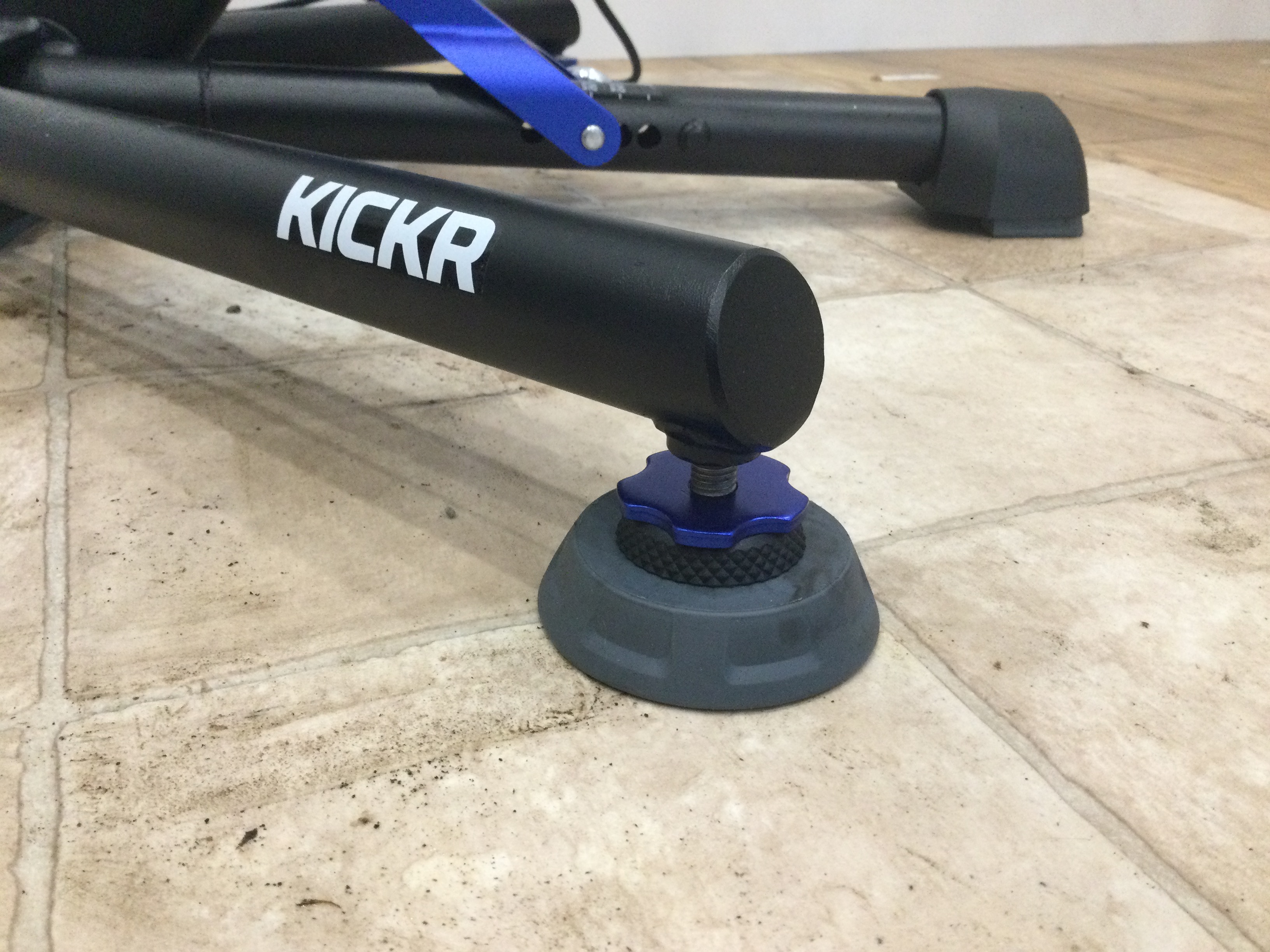
There are three different feet options to give an optimum side-to-side feel
The only part of set up that takes a bit more care and thought is selecting and installing the rear-axle adapters to match those of your rear wheel (compatible with 130 and 135mm QR; 12x142 and 148mm). Once you’ve lined up all the adapters, it’s actually quite a simple job, probably the biggest difficulty comes in knowing what standard you actually run. If in doubt, the easiest way is to resort to the internet and look up the spec of your bike / frame.
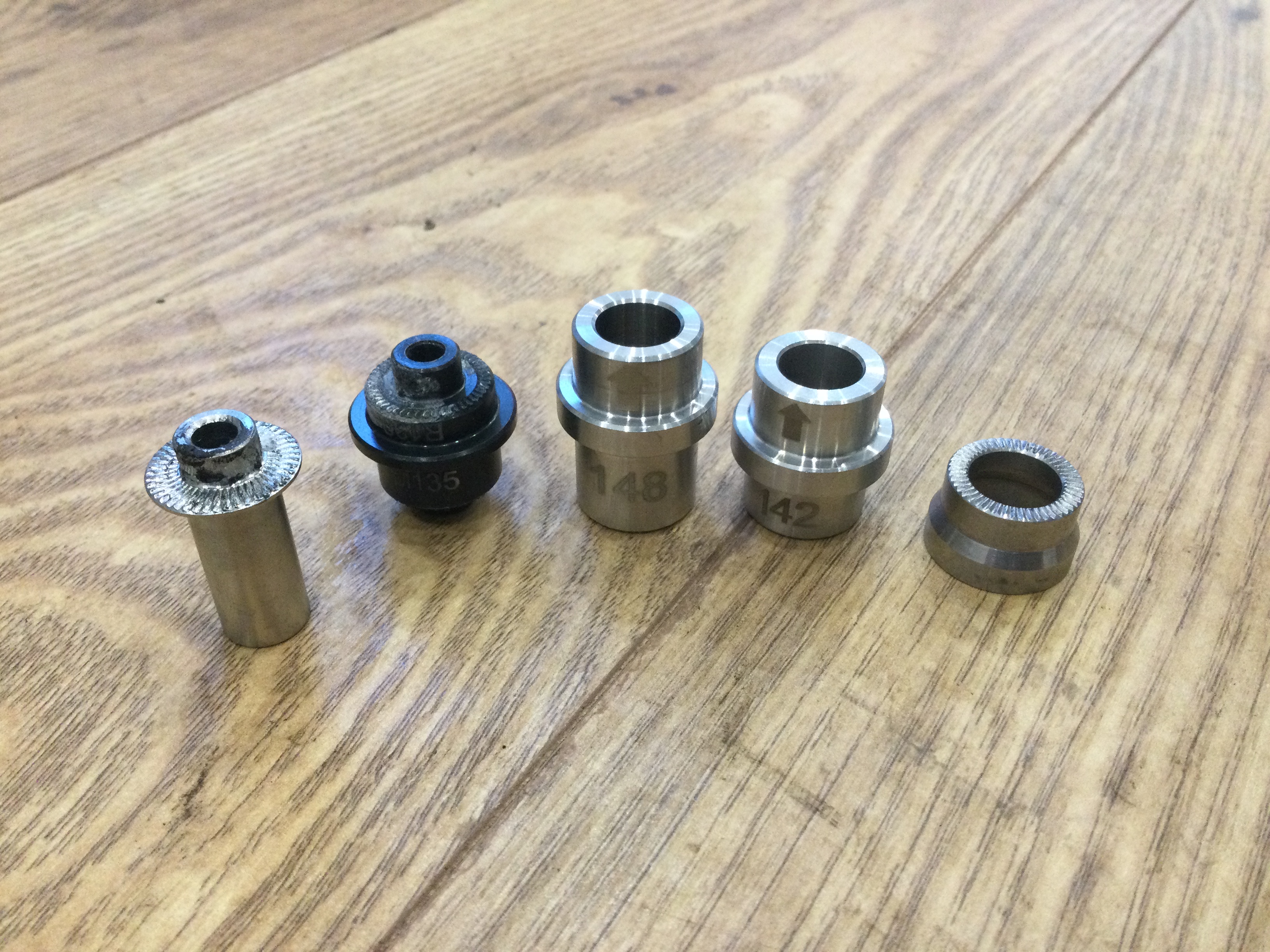
Rear axle options to match your frame
The Kickr V6 comes complete with an 11 speed 11-28t Sunrace cassette. If you don’t run an 11 cassette the existing freehub body will also take a 9, 10 speed Shimano or SRAM cassette or a 12 speed Shimano road cassette. You’ll need the appropriate tools to change the cassette and either swap your existing one off your rear wheel or buy a second one for your trainer. If you run a Campagnola cassette or SRAM XD/XDR you’ll need to buy an additional freehub body as well as a cassette. There is no freehub available for Shimano’s Microspine system, which is found on 12 speed mountain bike drivetrains.
Given the adaptability of the Kickr to accommodate different wheel sizes and the movement of the industry towards 12 speed cassettes (and various freehub types), I’d like to see an option to select your freehub and cassette at purchase so it’s not an additional cost to run the Kickr with your chosen drivetrain.
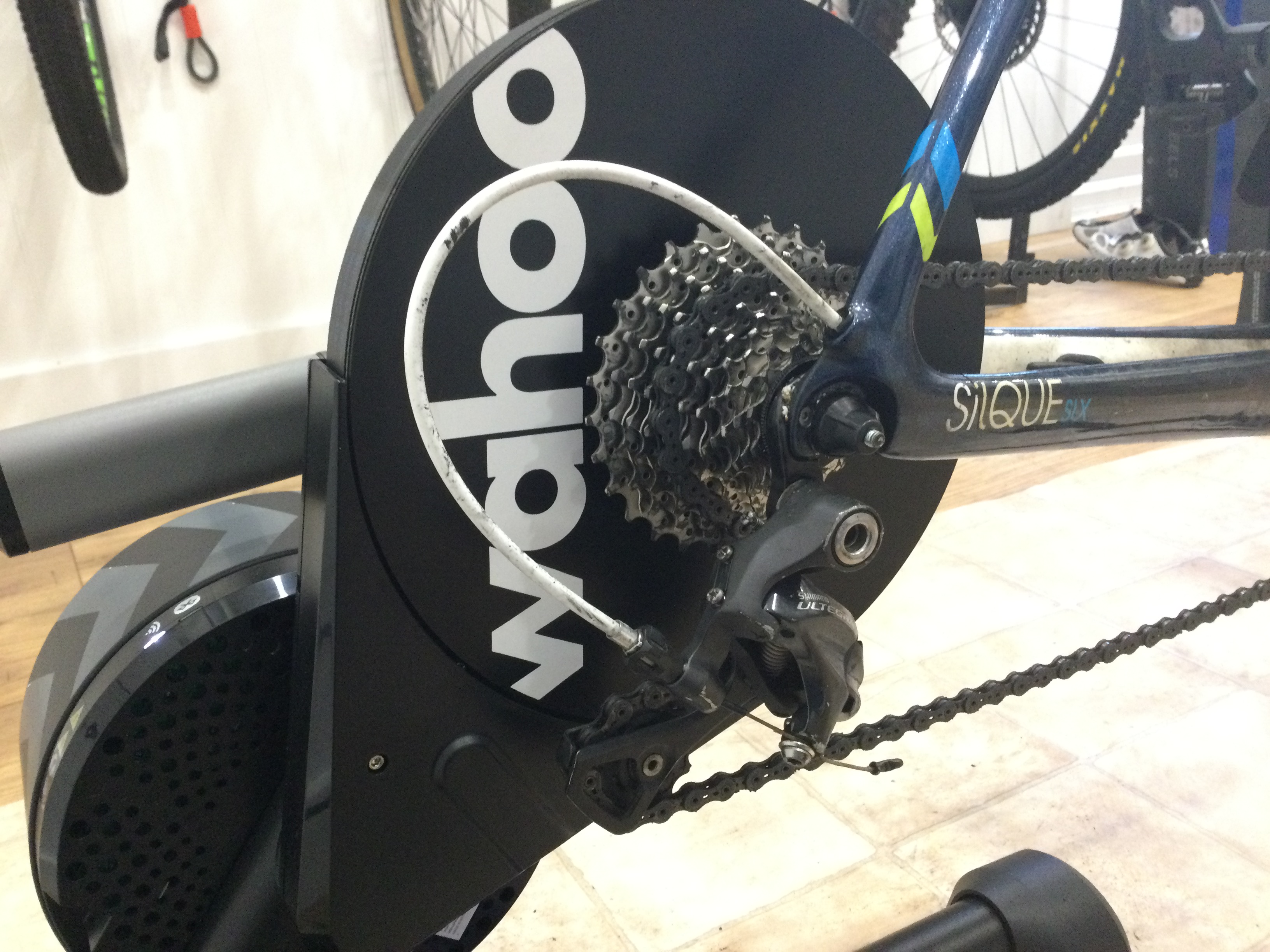
Installed using 135mm QR axle options and the 11 speed Sunrace cassette (and a filthy chain from outdoor winter riding)
The physical set up of the Kickr may have been easy; the technological one threw me a few more challenges.
First up, ANT connection via my Garmin Edge 1000 bike computer. Despite the relative age of my unit, connection via ANT was easy via the Garmin’s “add a sensor” menu option. The Wahoo Tickr heart rate monitor (an additional purchase to the Kickr) also connected easily. The Garmin re-connected to the Kickr and Tickr each session without any issue and the connection stayed steady throughout all the sessions that I either controlled or recorded on the Edge.
Next, the Bluetooth. I found the Bluetooth connectivity to my iPhone and iPad be pretty unstable, even with all other Bluetooth devices switched off. For example, every time I powered up the Kickr it wouldn't automatically connect so I had to manually do this (although annoyingly it would pick up my power cranks if these were transmitting). I often had to connect to each of the Wahoo System, X and RGT indoor cycling training apps separately despite them being “integrated”.
Even after this I often found that I’d lose the connection between the app and either the Kickr or Tickr by the start of the session. I think most of this issue lay with the apps. To get a connection to Wahoo X, I had to reinstall it almost every use, the System and RGT apps were a little more consistent. Friends who are owners of previous Kickr models assured me once I got set up, then things tended to be stable. I didn’t wait to get to this point though and made use of the new WiFi connection.
Once I sorted the WiFi connection in my garage with a plug-in booster, then it was all systems go and my Bluetooth experience was consigned to the past. On the first attempt I couldn’t get the Kickr to see my WiFi network in the System app, but once it did, connection was automatic each time I switched on the Kickr and regardless of which app I used. Of course, if you have an unstable WiFi connection then this solution may be less perfect for you (although the hardwire option still remains).
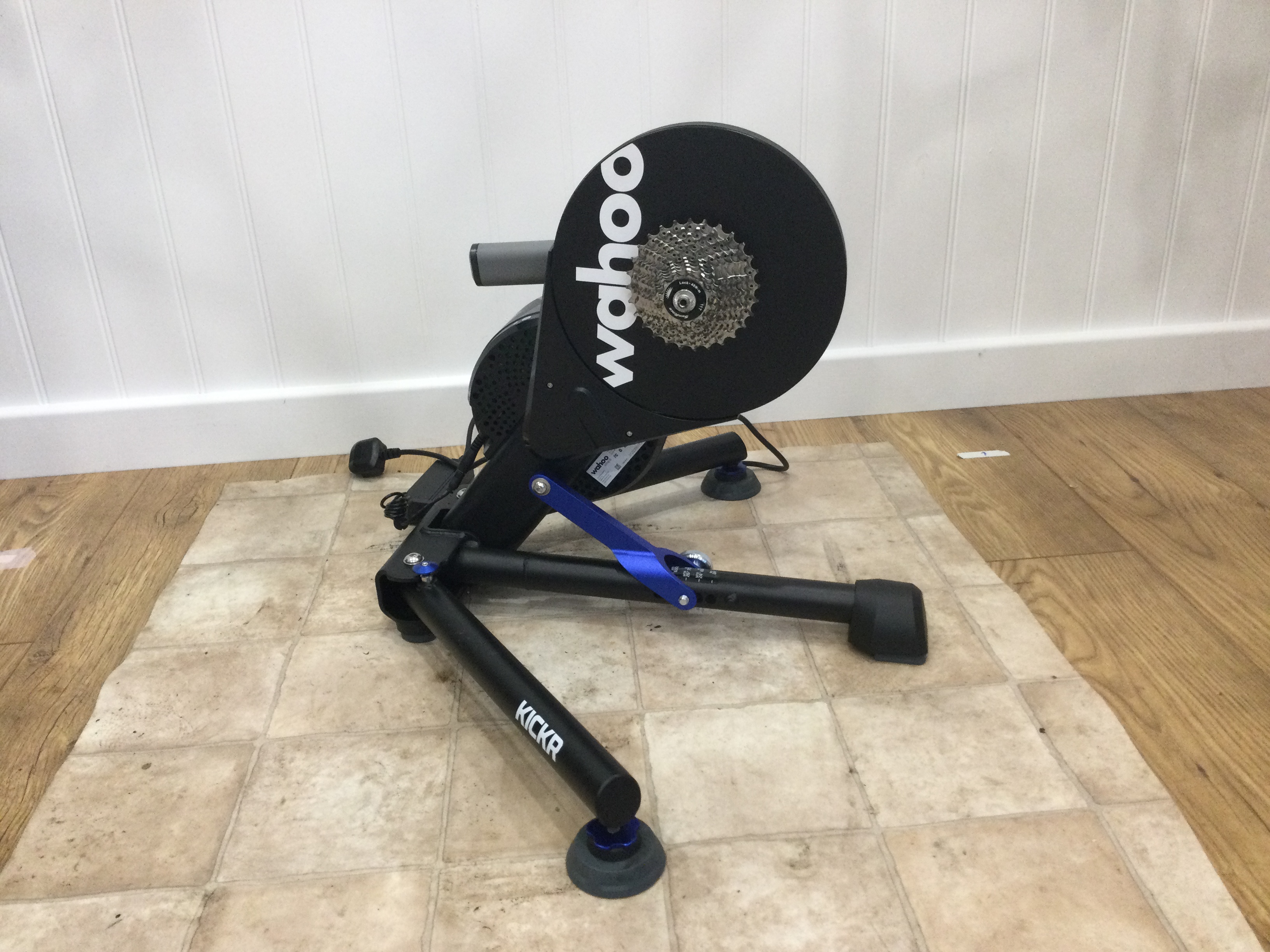
Wahoo Kickr V6: The ride
Technological connections sorted it was finally time to threw my leg over my bike and get riding (nowhere).
First things, the feel. The motion is incredibly smooth and quiet, perhaps unnervingly so. Did I notice the side to side motion offered by the AXIS feet? No, not really. But then again I didn’t feel like everything was rigidly held either (which I did appreciate for reducing the stresses on the rear triangle of my bike, more so than the actual ride feel.)
The biggest thing I noticed that didn’t reflect outdoor riding was the increased momentum I got coming off a sprint /effort which I suspect was due to the heavy flywheel taking more time to slow down than your bike would do outdoors.
Well, in truth the biggest thing I noticed is that I was staring at my garage wall, sweating buckets on a winter day, I didn’t have to steer my bike or change gear (when in ERG mode), so I’m actually not that bothered if it doesn’t feel exactly like the real thing.
Undoubtedly the ERG feature is fantastic in helping to achieve focused and quality sessions at different power outputs. For those unfamiliar with ERG mode, this is a setting where the resistance of the trainer automatically adjusts based on your current cycling cadence and torque (the force through the pedal) so that you hit your target power outputs. To find out more about training in ERG mode, we recently put the question ‘Should I be doing my Zwift sessions in ERG mode?’ to a cycling coach over here.
Adjustment in the resistance feels almost instantaneous as you change cadence or the programmed session reaches the start and end of each interval.
As well as being really helpful in hitting your target power in interval type sessions, it’s also fantastic when you just want to hit a longer steady state effort, as you don’t need to be constantly checking your data to know you’re still on target. The new ERG Ramp Mode did its job well and I was easily able to get back up to speed if I paused for a few seconds during an effort.
My only issue with the ERG feature is that it’s really difficult to switch off; great for discipline, less good for stopping yourself exploding when you’ve gone too far into the red. For example, during one session I’d just about topped out on my last zone 6 effort on. Usually I’d push as far as I could go before dropping a few gears and continuing at a slightly less heart-busting pace. During this session (which I was following on the Wahoo X app) I had to reach forward and try and press the small menu button on my laptop with a sweaty hand and blurred vision, choose a different tab, decrease the percentage power in single percentage points and then OK the changes. By the point I’d done this I’d come to a halt and the interval was over. Different software can make these changes a little quicker (like Zwift or on a Garmin head unit) or slower, although you still need to go through the app.
I’d like to see a development where you could toggle the level of the ERG mode setting by changing gear – with the option of turning it off completely once past a certain point. It would both simulate the real world and make it a whole lot easier to do during an effort. Developing the ERG mode so you could work to heart rate zones as well as power would be marvellous and help control for heart rate drift, which is reasonably common during indoor sessions.
And, finally, I did notice a little inconsistent quirk in the cadence measures. The Kickr features an integrated cadence measure derived from pedalling dynamics data. On the whole this was accurate, within one RPM of that from my 4iiii crank cadence sensor at RPM 30-120. One oddity was that during single-leg drills the cadence was halved even though speed and power measures were maintained. To make this even odder it wasn’t a consistent issue, occurring around half the time I tested it whether I measured on my Garmin or the Wahoo app. This is by no way a big issue in the real world, just a good reminder that simulated data is never as accurate as the real thing.
Wahoo Kickr V6: Power analysis
I cannot possibly verify whether the Kickr can really achieve its max resistance of 2,200W. But then it’s unlikely this is an issue for anyone so we’ll quickly move on.
Using ERG mode, I compared performance to my one sided 4iiii crank power meter and Favero Assioma Duo pedals. The data was closely matched across the whole session, with variations in the power curve from 10 seconds onwards no greater than three watts (1.5%). There was quite substantial variation for shorter time periods and maximum values, with over 30 watts difference (10%) between the 4iiii than the Kickr at three seconds.
I rather suspect that that error here falls with the one-sided cranks, as it isn’t seen from the pedals and the full data file from this session suggests the peak in 4iiii data is an outlying measure, and / or the data smoothing that you get with the Kickr which smooths out any half pedal stroke anomalies like this. Overall I was pretty happy how the values matched up and don’t feel the need to adjust my indoor and outdoor power zones to account for any measurement variation.
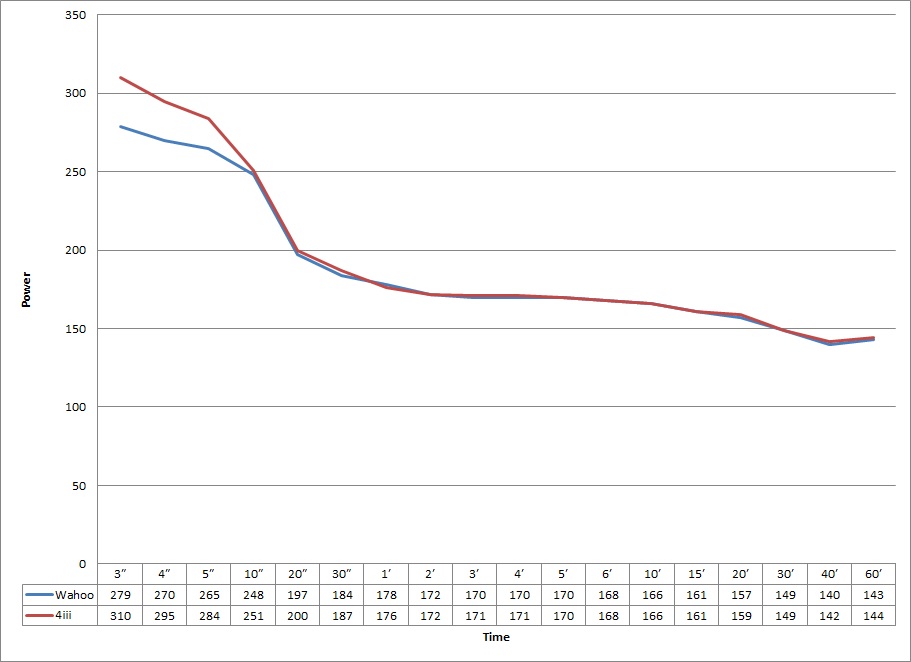
Wahoo Kickr 6: Value and conclusions
The Wahoo Kickr direct drive smart trainer is an amazing piece of kit. Its improved connectivity and development of the ERG mode have improved performance and reliability that much further.
As we’ve seen across many manufacturers of later, the latest versions of smart trainers and bikes are accompanied by big increases in prices which probably reflect current inflationary pressures more than product developments. The Kickr V6 retails for $1,300 / £1,100, a $/£100 increase in the price of the previous Wahoo Kickr V5 model (which at the time of writing is on sale for $1000 / £900). On the upside, this is $/£100 cheaper than the closely matched Tacx NEO 2T smart trainer.
We are now in the days of smart trainer evolution – not revolution – so, depending on your existing smart trainer (or not), you may not see the latest version of the Wahoo Kickr as worth the money. Having said that, given the massive developments we’re seeing in the smart trainer apps like Wahoo X, the WiFi enabled Kickr stands a better chance than many other trainers in keeping pace with the future.

Thank you for reading 20 articles this month* Join now for unlimited access
Enjoy your first month for just £1 / $1 / €1
*Read 5 free articles per month without a subscription

Join now for unlimited access
Try first month for just £1 / $1 / €1
Get The Leadout Newsletter
The latest race content, interviews, features, reviews and expert buying guides, direct to your inbox!
Rachel has been writing about and reviewing bike tech for the last 10 years. Cynical by nature, Rachel never really trusts the marketing hype and prefers to give products a mighty good testing before deciding whether they're worth buying or not.
Rachel's first riding love is mountain biking where she's been European and UK 24hr Champion on more than one occasion. She's not just confined to the trails though and regularly rides - and occasionally races - on gravel and road too.
-
 'I'll take a top 10, that's alright in the end' - Fred Wright finishes best of British at Paris-Roubaix
'I'll take a top 10, that's alright in the end' - Fred Wright finishes best of British at Paris-RoubaixBahrain-Victorious rider came back from a mechanical on the Arenberg to place ninth
By Adam Becket Published
-
 'This is the furthest ride I've actually ever done' - Matthew Brennan lights up Paris-Roubaix at 19 years old
'This is the furthest ride I've actually ever done' - Matthew Brennan lights up Paris-Roubaix at 19 years oldThe day's youngest rider reflects on 'killer' Monument debut
By Tom Davidson Published
-
 'One of the hardest races I've ever done in my life' - Tadej Pogačar finishes runner-up on Paris-Roubaix debut after crash
'One of the hardest races I've ever done in my life' - Tadej Pogačar finishes runner-up on Paris-Roubaix debut after crashWorld champion reacts to 'extremely hard' battle with Mathieu van der Poel
By Tom Davidson Published